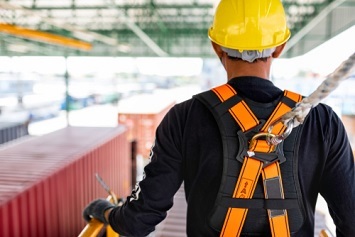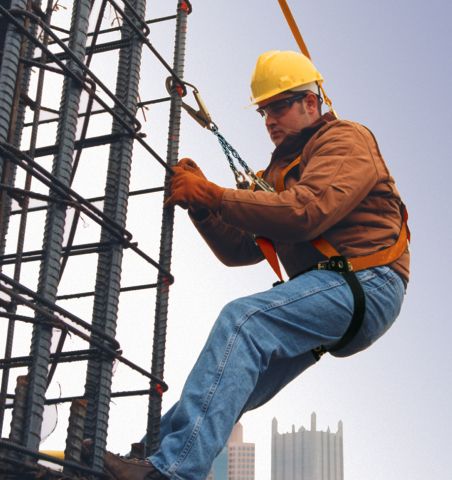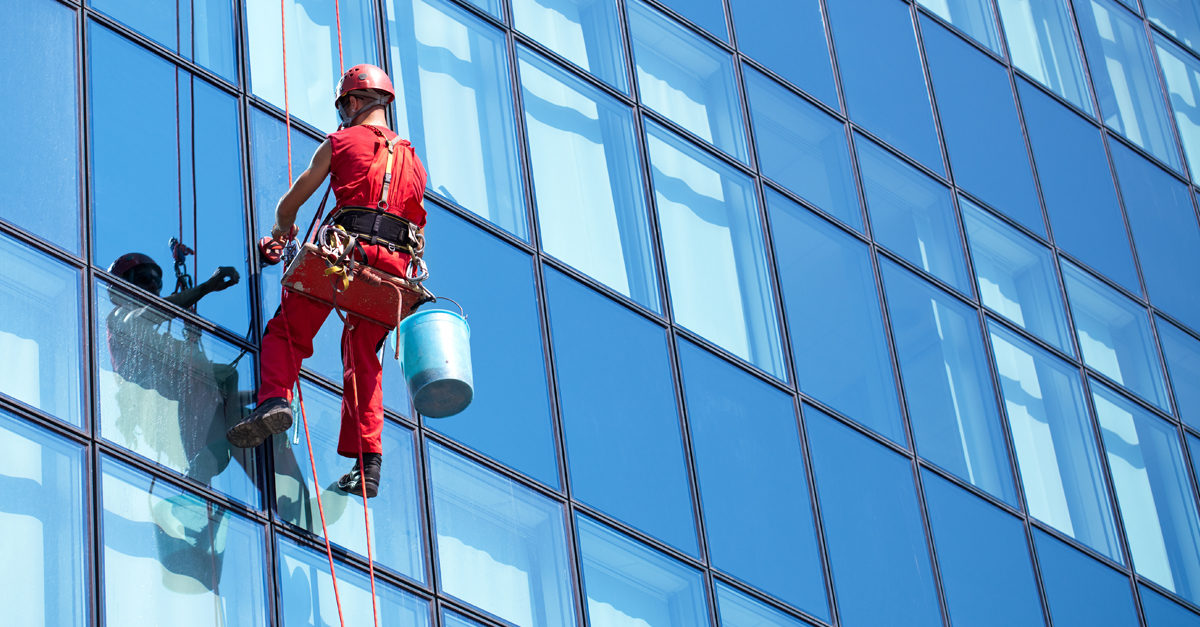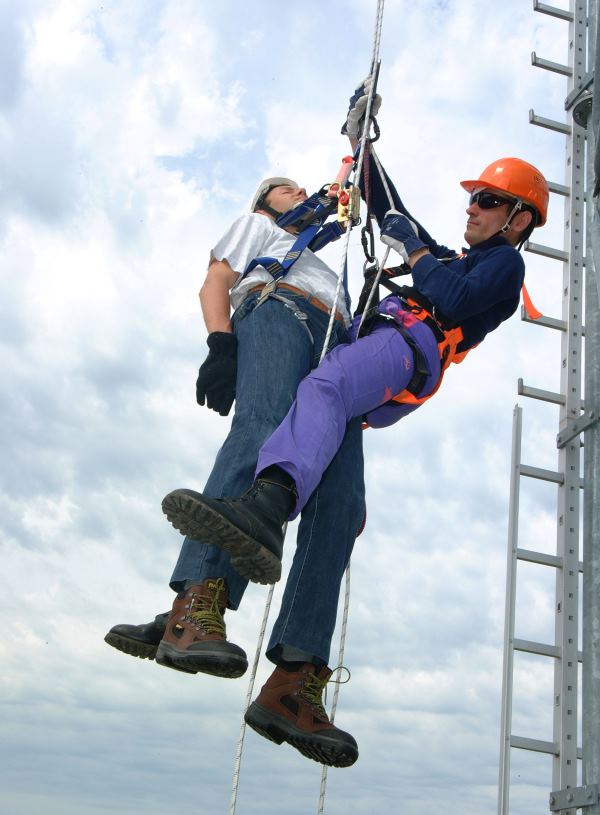Four Types of Active Fall Protection Equipment and OSHA Standards
Passive fall protection—such as guardrails, netting, and safety gates—is rarely cost-effective and may not even be possible to incorporate into a construction project. However, falls remain a leading cause of injury and death in the construction industry. For this reason, it is vital that employers provide their employees with active fall protection equipment and teach them to use it properly. We’ll discuss four types of fall protection, OSHA safety standards they must meet and which fall protection component allows the least amount of free fall.
1. Personal Fall Arrest System: 1926.502(d)
 The
goal
of
this
form
of
fall
protection
is
to
stop,
or
arrest,
an
employee
who
is
falling
from
a
walking
surface.
It
consists
of
a
combination
of
the
following
components,
which
OSHA
calls
“the
A,
B,
Cs
of
personal
fall
arrest
systems.”
The
goal
of
this
form
of
fall
protection
is
to
stop,
or
arrest,
an
employee
who
is
falling
from
a
walking
surface.
It
consists
of
a
combination
of
the
following
components,
which
OSHA
calls
“the
A,
B,
Cs
of
personal
fall
arrest
systems.”
- Anchorages. According to OSHA, “anchorage means a secure point of attachment for equipment such as lifelines, lanyards, or deceleration devices.” Examples include I-beams and tie off straps, which must be able to support a minimum of 5,000 pounds per worker or at least twice the expected load of a person falling 6 feet. OSHA requires that anchorages attached to a complete fall arrest system remain separate from anchorages that support or suspend platforms. It is crucial that all anchor points are designed and installed by an OSHA-approved, qualified person.
- Body harness. Body harnesses must secure an employee in a way that would minimize the arresting force of a fall to 1,800 pounds or less. It must be capable of supporting 310 pounds of combined tool and body weight. Never attach a body harness to a guardrail system or hoist.
-
Components.
These
include
connectors,
lanyards,
deceleration
devices,
and
self-retracting
lifelines.
- Connectors: OSHA dictates that D-rings and snaphooks ‘must have a minimum tensile strength of 5,000 pounds and be proof-tested to a minimum tensile load of 3,600 pounds without cracking, breaking, or becoming permanently deformed.’
- Lifelines & Lanyards: Except during elevator shaft construction, each employee must be attached to a separate lifeline or lanyard. Vertical lifelines and lanyards must have a minimum breaking strength of 5,000 pounds and be protected from cuts or abrasions. When fully extended, self-retractable lifelines and lanyards that automatically limit free fall distance to 2 feet must be able to support a tensile load of at least 3,000 pounds. Other types of lifelines and lanyards include horizontal, ripstitch, and tearing and deforming. Ropes and straps (webbing) used in their construction must be made of synthetic fibers.
- Deceleration devices: A deceleration device is any mechanism that safely slows down a fall and limits the energy imposed on an employee once the fall has stopped. Examples of deceleration devices include rope grabs, ripstitch lanyards, tearing and deforming lanyards, and self-retracting lifelines and lanyards.
2. Positioning System: 1926.502(e)
 Also
called
work-positioning
equipment,
a
positioning
system
is
a
body
belt
or
body
harness
system
that
allows
a
worker
to
be
supported
on
an
elevated
vertical
surface,
such
as
a
wall,
window
sill,
or
ladder,
and
work
with
both
hands
free.
OSHA
code
dictates
that
the
body
belt
or
body
harness
used
in
conjunction
with
a
positioning
system
must
limit
free
fall
distance
to
2
feet
and
be
capable
of
supporting
at
least
twice
the
potential
impact
of
a
worker’s
fall
or
3,000
pounds,
whichever
is
greater.
The
restraint
(tether)
lines
must
also
have
a
minimum
breaking
strength
of
3,000
pounds.
Snaphooks
other
than
the
locking
type
must
not
be
connected
to
each
other.
Also
called
work-positioning
equipment,
a
positioning
system
is
a
body
belt
or
body
harness
system
that
allows
a
worker
to
be
supported
on
an
elevated
vertical
surface,
such
as
a
wall,
window
sill,
or
ladder,
and
work
with
both
hands
free.
OSHA
code
dictates
that
the
body
belt
or
body
harness
used
in
conjunction
with
a
positioning
system
must
limit
free
fall
distance
to
2
feet
and
be
capable
of
supporting
at
least
twice
the
potential
impact
of
a
worker’s
fall
or
3,000
pounds,
whichever
is
greater.
The
restraint
(tether)
lines
must
also
have
a
minimum
breaking
strength
of
3,000
pounds.
Snaphooks
other
than
the
locking
type
must
not
be
connected
to
each
other.
3. Suspension System: 1926.452(o)
 Suspension
systems
are
commonly
used
by
painters
and
window
washers,
as
they
allow
employees
to
lift
and
lower
themselves
along
a
vertical
surface
while
working
hands-free.
A
fall
arrest
system
must
still
be
used
alongside
a
suspension
system.
Suspension
systems
are
commonly
used
by
painters
and
window
washers,
as
they
allow
employees
to
lift
and
lower
themselves
along
a
vertical
surface
while
working
hands-free.
A
fall
arrest
system
must
still
be
used
alongside
a
suspension
system.
4. Retrieval System: 1926.502(d)(20)
 OSHA
requires
that
“the
employer
shall
provide
for
prompt
rescue
of
employees
in
the
event
of
a
fall
or
shall
assure
that
employees
are
able
to
rescue
themselves.”
Retrieving
a
worker
who
has
fallen
is
essential
to
a
fall
protection
plan.
Although
OSHA
does
not
provide
specific
instructions
as
to
how
retrieval
should
be
accomplished,
it
does
outline
some
guidelines
that
should
govern
a
rescue
plan.
This
is
especially
important
in
cases
that
involve
enclosed
spaces
such
as
manholes.
Rescue
equipment
should
be
connected
to
the
employee
at
the
outset
and
is
not
to
be
used
for
purposes
other
than
rescuing
a
fallen
worker.
A
rescue
plan
must
also
consider
the
safety
of
the
rescuer.
Retrieval
equipment
"must
enable
a
rescuer
to
remove
an
injured
employee
from
the
enclosed
space
quickly
and
without
injury
to
the
rescuer
or
further
harm
to
the
fallen
employee."
OSHA
requires
that
“the
employer
shall
provide
for
prompt
rescue
of
employees
in
the
event
of
a
fall
or
shall
assure
that
employees
are
able
to
rescue
themselves.”
Retrieving
a
worker
who
has
fallen
is
essential
to
a
fall
protection
plan.
Although
OSHA
does
not
provide
specific
instructions
as
to
how
retrieval
should
be
accomplished,
it
does
outline
some
guidelines
that
should
govern
a
rescue
plan.
This
is
especially
important
in
cases
that
involve
enclosed
spaces
such
as
manholes.
Rescue
equipment
should
be
connected
to
the
employee
at
the
outset
and
is
not
to
be
used
for
purposes
other
than
rescuing
a
fallen
worker.
A
rescue
plan
must
also
consider
the
safety
of
the
rescuer.
Retrieval
equipment
"must
enable
a
rescuer
to
remove
an
injured
employee
from
the
enclosed
space
quickly
and
without
injury
to
the
rescuer
or
further
harm
to
the
fallen
employee."
CHOOSE AMERICRANE AND HOIST CORP. FOR RELIABLE FALL PROTECTION EQUIPMENT
Americrane and Hoist Corp. is your number one choice for fall protection equipment. Our Elk River brand adjustable harnesses offer custom-fit comfort without sacrificing safety. You can also choose from several energy-absorbing lanyards, self-retracting lifelines, and anchorage connectors. Each of our products is built with the highest quality of craftsmanship, a testament to our keen focus on worker safety.
Contact Us | Hoists | Hoist Parts | Cranes | Beam Clamps | Inspections & Training | About Us | Customer Reviews | Privacy Policy | Shipping & Returns
Americrane & Hoist Corporation | 13311 Enterprise Ave | Cleveland, Ohio 44135 | Phone: 216-267-9100 | Fax: 216-267-9131
All Rights Reserved 2026, Americrane & Hoist Corporation
Admin Login | Web Site Developed by Alt Media Studios







